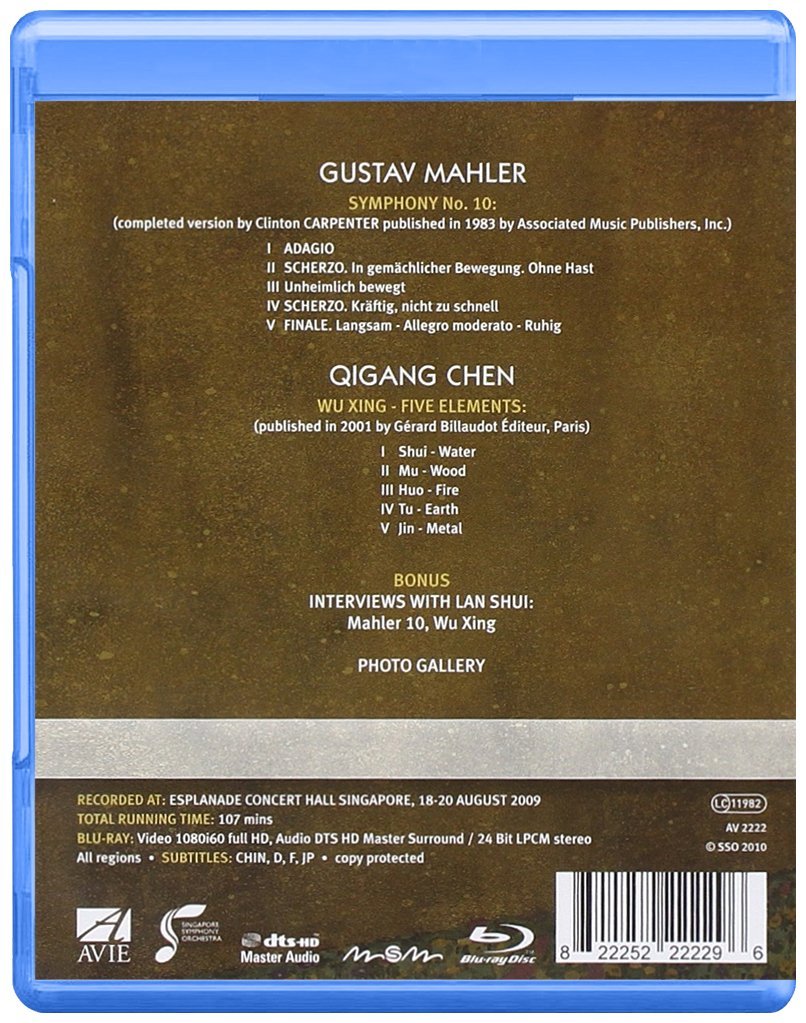

Mahler Symphony No. 10 concert. Pieces performed are:
Mahler Symphony No. 10 (Clinton Carpenter version)
Qigang Chen: Wu Xing (Five Elements)
Lan Shui conducts the Singapore Symphony Orchestra in 2009. TV direction by Ruth Käch. Released 2010, this disc has 5.1 dts-HD Master Audio surround sound. Grade: F
Mahler only completed the first movement - the famous Adagio - of what was intended to be his 10th symphony. This recording is of a Symphony No. 10 as completed by Clinton Carpenter. This title remains (October 2017) the only video of a Carpenter version of Mahler 10. Qigang Chen is a native of China who became a French citizen. He is a prolific composer, and Wu Xing (Five Elements ) is one of his better known works.
Singapore, a tiny polyglot nation of 5 million souls, has one of the most successful economies on earth. It has a symphony orchestra that is working its way up playing western classical music. This title came out in 2010. This recording reveals that the Singapore Symphony Orchestra had in 2009 yet more steep slopes to climb before it could compete with groups like the Berlin Philharmoniker, the Lucerne Festival Orchestra, and the Saito Kinen Orchestra from Japan. The playing and sound recording is weak and a bit painful to hear. Now let's discuss details from both pieces on the program.
Mahler Symphony No. 10 - Carpenter Version
Our first screenshot is one of several whole-orchestra shots. The resolution is very soft, almost like a DVD. The playing of the band is that of a semi-pro or an aggressive amateur group. The SQ is generally dry and thin:
Conductor Lan Shui:
One of a number of multiple-subject, trick-photography images, this time with the conductor's face included:
A conductor-over-backs shot is next below:
The close-ups are quite pleasing:
And next below is an excellent multi-section angle:
But there are quiet a few shots with serious errors such as the poor framing in the next two images below:
What we have seen so far would indicate a mediocre video made on a limited budget. But later in the film I get the impression this video may have been some kind of teaching vehicle. The next 7 images smack of student experiments or stunts that somehow got taken seriously. In the last 14 minutes of this film of Mahler 10, there are 7 "white out" segments similar to the final screenshots:
The next images were made, I think, by pointing cameras into bright lights to burn out the sensors for a "psychedelic" effect:
I recently ran the numbers on this Mahler 10 in a Classical Music Wonk Worksheet.
There are 79 minutes, 42 seconds of music divided into 401 video clips. This yields a comfortable pace of 12 seconds per clip.
Here's the clip breakdown:
Conductor shots = 112
Conductor-over-backs shots = 16
Solo and other small-scale clips = 164
*Large-scale clips = 28
*Part-orchestra clips = 2
*Whole-orchestra clips = 17
Instrument-only clips = 45
Other low-value shots = 17 (including anthills, trick photography images, and "whiteouts")
*Other high value=0
There are only 47 "supershots" (add up the * numbers above of 28+2+17=47). So the supershots are only 10% of the total clips (128/401). Conductor shots total 128 (112+16), and conductor shots use up 32% of the clips (128/401).
HDVDarts.com has established the following rules-of-thumb to identify a Blu-ray with DVDitis:
“A good symphony HDVD should have a slow pace with more than 10 seconds per video clip on average. 20 to 40% of the clips should be large-scale "supershots." Conductor shots should be less (way less really) than 20% of the clips in the video.”
Subject title passes the pace test (with the help of many long panning and zooming shots). But it resoundingly flunks the test for supershots and conductor views. These bad results together with the huge number of IO shots, the many anthills, and the inexplicable 7 white-out events at the end of the piece make this the worst video that has come to my attention in the almost 8 years we have been reviewing fine-arts videos.
Now for a grade. This video was released on the Avie label, an enterprise that lets artists retain ownership of the rights and profits while publishing their work. So now you get the picture: this release was not vetted by anyone for commercial viability. Maybe it's a vanity piece. Maybe it was a pet project of someone in the Singapore government. This recording could not have been released by anyone with something to lose. The only grade for this in an F. Still, you might still find it worthwhile if you have a special interest in Singapore or the Carpenter version of Mahler 10.
Wu Xing (Five Elements)
Five Elements is an interesting composition which lasts about 13 minutes and celebrates (1) Water, (2) Wood, (3) Fire, (4) Earth, and (5) Metal. It's much better played by the SSO than the Mahler 10. But the video is a disaster. The first 11 minutes of the piece are presented with a "mask" or "frame" blocking out about 40% of the image area and allowing the viewer to see mostly instrument-only and conductor shots.
Our first screenshot below makes it clear that Five Elements played by the entire symphony orchestra:
And now in the next shot below, you see the mask and pair of mallets playing a keyboard percussion instrument:
At times, trick-photography is revealed behind the mask:
Or the conductor's ghostly hand conducts (a kind of "instrument only" shot of the conductor):
And here next below is a weird combo of an IO shot and a conductor's-hand-only shot:
After 11 minutes of cute tricks, the video suddenly shifts (amidst the final Metal section) and concludes the piece with about 2 minutes of more or less normal images of the orchestra :
There would be no point in discussing the Five Elements video in more detail. It's even worse than the Mahler 10 video and also gets an F. I can't think of any reason to want this Five Elements. (I would be interested, however, in seeing Five Elements live or in a proper recording.)
Here a clip from the Mahler 10:
OR






















